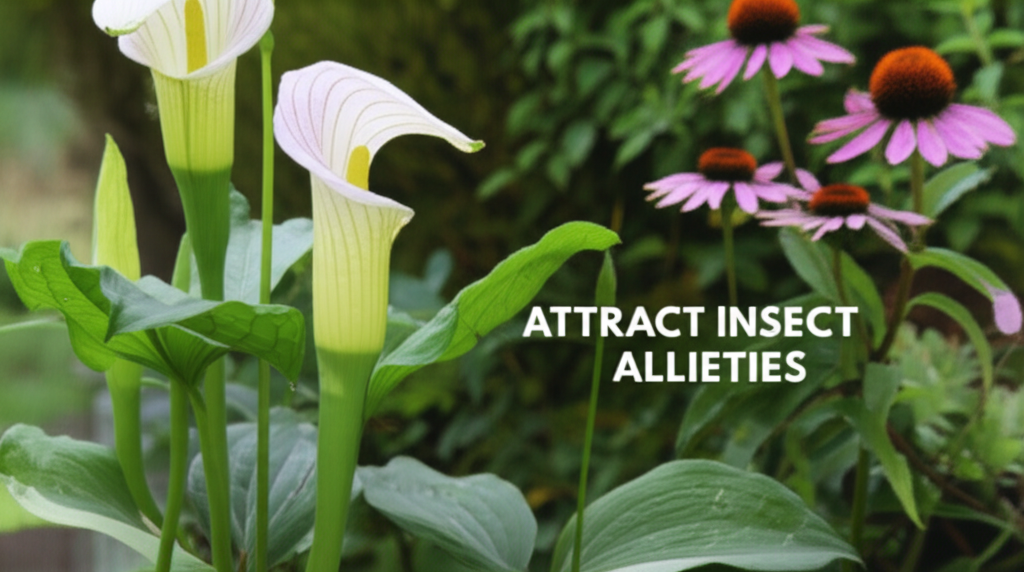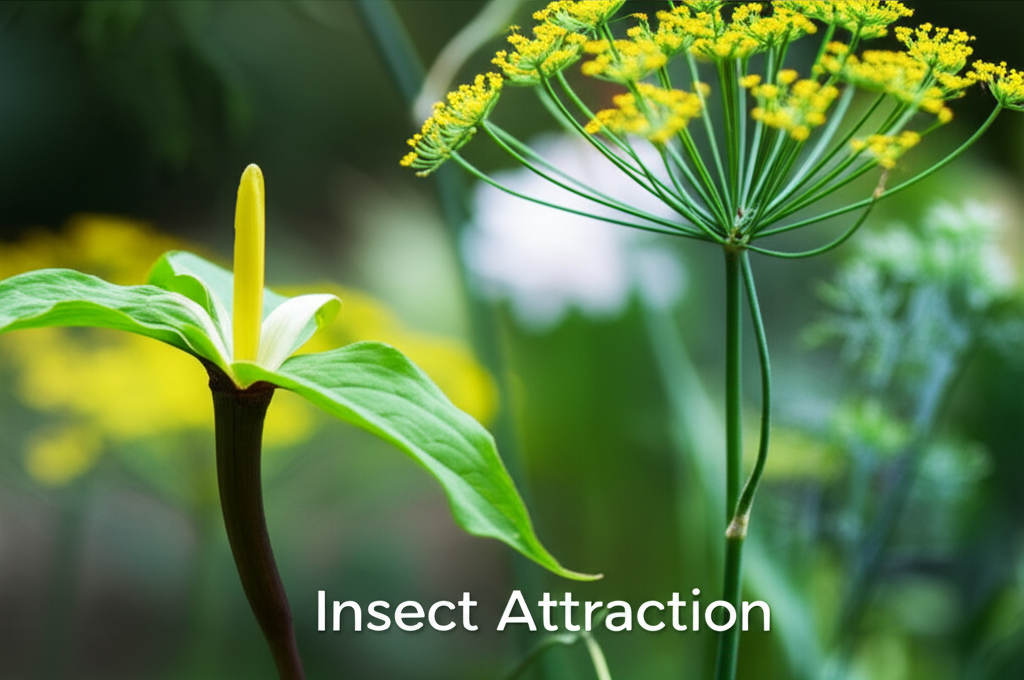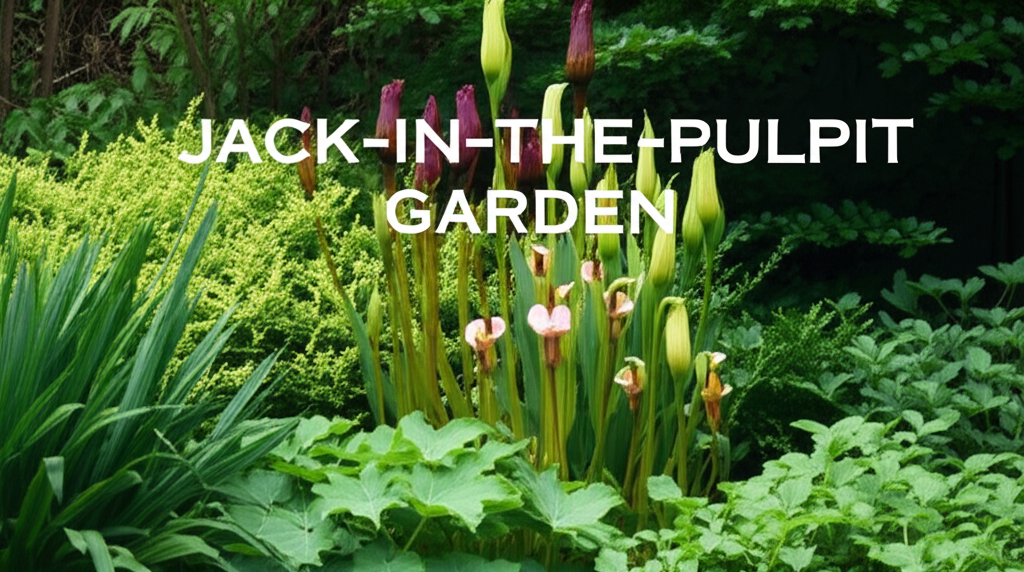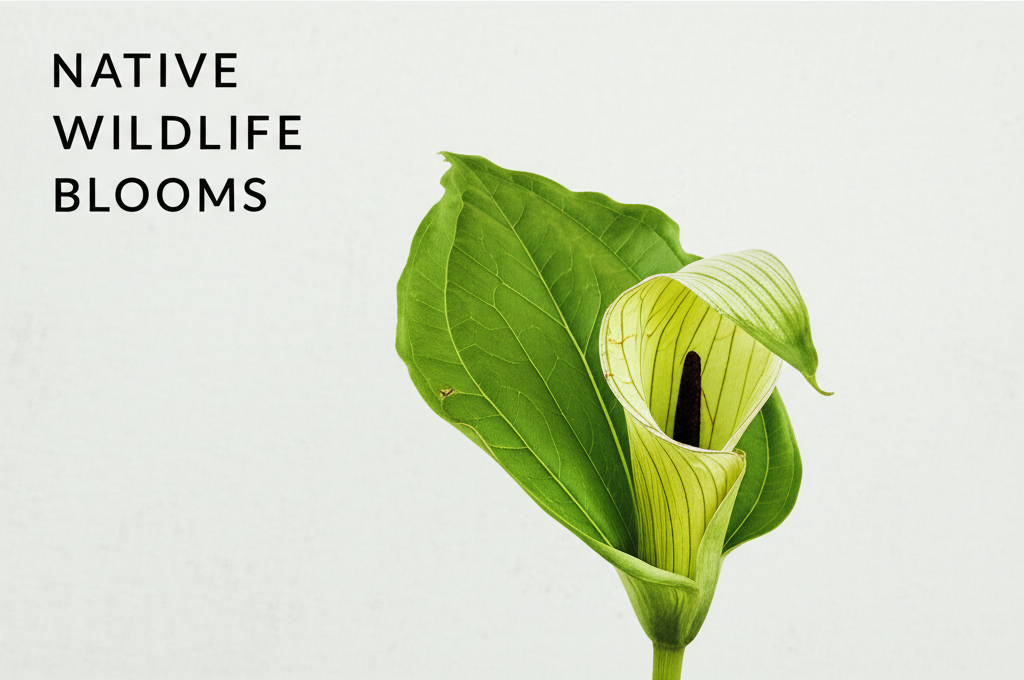The Intriguing Appeal of Jack-in-the-Pulpit
Jack-in-the-Pulpit (Arisaema triphyllum) is a woodland wildflower native to eastern North America, renowned for its unique and captivating inflorescence. This plant, often found in moist, shaded environments, features a hooded spathe that encloses a central spadix, resembling a preacher in a pulpit. Beyond its striking visual appeal, Jack-in-the-Pulpit plays a crucial role in its native ecosystem, and understanding its ecological interactions can unlock the secrets to successful companion planting, particularly for attracting beneficial insects.
Companion planting, at its core, is the practice of strategically placing different plant species together to create a mutually beneficial environment. This can involve deterring pests, attracting pollinators, improving soil health, or even enhancing the flavor of edible crops. For native wildflowers like Jack-in-the-Pulpit, this approach can be particularly effective in recreating a miniature ecosystem that supports both the plant and the surrounding insect populations.
Understanding the Needs of Jack-in-the-Pulpit

To effectively implement companion planting strategies for Jack-in-the-Pulpit, it’s essential to first understand its specific growing requirements. This knowledge forms the foundation for selecting appropriate companion plants that will thrive alongside it.
Habitat and Environmental Preferences
Jack-in-the-Pulpit prefers shady to partially shaded conditions, often found thriving in the dappled light of deciduous forests. It thrives in moist, humus-rich soil with a slightly acidic to neutral pH. Consistent moisture is key, as the plant can be sensitive to drought. It typically grows in woodlands, swamps, and damp meadows.
Seasonal Growth Cycle
The growth cycle of Jack-in-the-Pulpit begins in early spring, with the emergence of its characteristic leaves and the distinctive spathe and spadix. After pollination, the spathe wilts, and a cluster of bright red berries develops on the spadix in late summer or early fall. These berries are a food source for various wildlife. The plant then goes dormant in the winter, with the foliage dying back.
The Role of Companion Planting in Insect Attraction
Companion planting can be a powerful tool for attracting a diverse array of beneficial insects to your garden, creating a balanced ecosystem that can naturally manage pest populations and enhance pollination. For Jack-in-the-Pulpit, the goal is to create an environment that not only supports its growth but also provides resources and habitat for insects that can benefit the surrounding garden.
Attracting Pollinators
While Jack-in-the-Pulpit itself is not primarily pollinated by typical bees or butterflies, its bloom period often coincides with the emergence of early spring pollinators. Planting species that attract these crucial insects can indirectly benefit the broader garden ecosystem. Furthermore, some specialized flies and gnats are known to be attracted to the unique scent and structure of the Jack-in-the-Pulpit’s inflorescence, aiding in its pollination.
Beneficial Insects for Pest Control
A well-designed companion planting scheme can attract insects that prey on common garden pests, such as aphids, spider mites, and slugs, which can sometimes affect young Jack-in-the-Pulpit plants or their neighbors. These beneficial predators include ladybugs, lacewings, hoverflies, and various species of predatory wasps.
Creating Habitat and Food Sources
Beyond attracting pollinators and pest controllers, companion plants can offer vital habitat and food sources for a wider range of insects. This includes providing nectar and pollen for a diverse insect community, as well as shelter and nesting sites.
Key Companion Plants for Jack-in-the-Pulpit
Selecting the right companion plants is crucial for maximizing the benefits of this planting strategy. The ideal companions will share similar growing conditions, complement Jack-in-the-Pulpit’s aesthetic, and actively contribute to attracting beneficial insects.
Shade-Tolerant Wildflowers and Perennials
Given Jack-in-the-Pulpit’s preference for shade, focusing on other woodland natives is a logical starting point. These plants will naturally thrive in similar microclimates and contribute to a cohesive woodland garden feel.
Ferns
Various fern species, such as Maidenhair Fern (Adiantum pedatum) or Christmas Fern (Polystichum acrostichoides), are excellent companions. They appreciate the same moist, shaded conditions and their delicate fronds provide a beautiful contrast to the bold structure of Jack-in-the-Pulpit. Ferns also offer shelter for small ground-dwelling insects.
Wild Ginger (Asarum canadense)
This low-growing groundcover thrives in similar shady, moist environments. Its heart-shaped leaves create a lush carpet around the base of the Jack-in-the-Pulpit, helping to retain soil moisture and suppress weeds. Wild ginger flowers are also known to attract a specific group of flies, contributing to biodiversity.
Solomon’s Seal
(Polygonatum biflorum)
With its gracefully arching stems and pendulous white flowers, Solomon’s Seal is an elegant companion. It also prefers shade and moist soil. The tubular flowers of Solomon’s Seal are a good nectar source for long-tongued bees and hoverflies.
Trillium (Trillium spp.)
These iconic woodland wildflowers share the preference for dappled shade and rich, moist soil. Planting various Trillium species alongside Jack-in-the-Pulpit creates a stunning display of native spring ephemerals. Their blooms can attract early-season pollinators.
Nectar and Pollen-Rich Flowers
Incorporating plants known for their high nectar and pollen production can significantly boost the insect attraction of the garden. Even in a shaded environment, certain species can flourish and provide vital resources.
Bleeding Heart
(Dicentra spectabilis or native Dicentra eximia)
The distinctive heart-shaped flowers of Bleeding Heart are a beautiful addition. They prefer partial shade and moist soil and their nectar can attract bees and other pollinators.
Columbine (Aquilegia canadensis)
The unique spurred flowers of the native Columbine are particularly attractive to long-tongued bees, such as bumblebees, and hummingbirds. It tolerates partial shade and can add a splash of red to the woodland garden.
Foamflower
(Tiarella cordifolia)
This delicate woodland perennial produces airy spikes of white, star-shaped flowers. It thrives in shade and moist soil and is a good attractant for small native bees and hoverflies.
Herbs that Tolerate Shade
While many herbs prefer full sun, some varieties can tolerate partial shade and offer dual benefits of attracting beneficial insects and potentially providing culinary herbs.
Mint (Mentha spp.)
Many mint varieties, while vigorous, can be planted in containers or managed to prevent them from spreading aggressively. Their small flowers are highly attractive to bees and hoverflies. Ensure they are in a location that receives some morning sun if possible.
Lemon Balm
(Melissa officinalis)
This member of the mint family also enjoys partial shade and has small, fragrant flowers that attract bees and other pollinators.
Creating a Synergistic Ecosystem: Key Facts and Comparisons
To effectively implement companion planting for Jack-in-the-Pulpit, understanding the specific benefits and requirements of potential companion plants is essential. The following table outlines key facts and offers a comparison of suitable species.
| Companion Plant | Scientific Name | Growing Conditions | Insect Attraction | Benefits to Jack-in-the-Pulpit | Potential Downsides |
|---|---|---|---|---|---|
| Maidenhair Fern | Adiantum pedatum | Shade, moist, well-drained soil | Provides habitat for small insects | Enhances soil moisture, aesthetically pleasing | Can be slow to establish |
| Wild Ginger | Asarum canadense | Deep shade, moist, humus-rich soil | Attracts specific flies | Groundcover, retains moisture, suppresses weeds | Spreads slowly, not edible in traditional sense |
| Solomon’s Seal | Polygonatum biflorum | Partial to full shade, moist, rich soil | Attracts bees and hoverflies | Aesthetically pleasing, good nectar source | Can be slow to reach mature size |
| Columbine | Aquilegia canadensis | Partial shade, moist, well-drained soil | Attracts bees, hummingbirds | Adds color, attracts pollinators | May require deadheading for repeat bloom |
| Mint | Mentha spp. | Partial shade, moist soil | Attracts bees, hoverflies | Can help deter some pests | Aggressive spreader, best in containers |
Practical Steps for Implementing Companion Planting
Successful companion planting involves more than just selecting the right plants; it also requires careful planning and execution to create a thriving environment.
Site Selection and Preparation
Choose a location that mimics the natural habitat of Jack-in-the-Pulpit: a shaded area with consistently moist, fertile soil. Amend the soil with compost or other organic matter to improve its structure and nutrient content. Ensure good drainage, as waterlogged conditions can lead to root rot.
Planting Strategies
- Interplanting: Directly plant companion species around the base of young Jack-in-the-Pulpit plants. This allows them to establish together and create an immediate beneficial microclimate.
- Grouping: Plant clusters of companion plants near Jack-in-the-Pulpit. This can create a more substantial habitat and food source for insects, drawing them into the area.
- Layering: Utilize plants of varying heights. Taller companions can provide dappled shade for younger Jack-in-the-Pulpit, while groundcovers can help retain moisture.
Ongoing Care and Maintenance
Once established, Jack-in-the-Pulpit and its companions generally require minimal maintenance.
- Watering: Ensure consistent moisture, especially during dry periods. Avoid overhead watering if possible, as this can promote fungal diseases.
- Mulching: Apply a layer of organic mulch, such as shredded bark or leaf mold, around the plants. This helps retain soil moisture, suppress weeds, and regulate soil temperature.
- Pest and Disease Monitoring: While companion planting aims to create a balanced ecosystem, it’s still important to monitor for any signs of pest infestations or diseases. Early detection and intervention, preferably with organic methods, are key.
- Weeding: Gently remove any competing weeds, being careful not to disturb the root systems of your desired plants.
Evaluating Success and Adjusting Your Approach
Observing your garden and noting which plants are thriving and which insects are visiting is essential for refining your companion planting strategy.
Observing Insect Activity
Regularly spend time in your garden observing the insect life. Note which plants are attracting the most pollinators and beneficial predators. This visual feedback is invaluable for understanding the effectiveness of your choices.
Assessing Plant Health
Monitor the health and vigor of your Jack-in-the-Pulpit and its companions. Healthy plants are indicative of a well-balanced ecosystem. Look for signs of stress, disease, or pest damage, and consider how your companion plants might be contributing to or alleviating these issues.
Adjusting for Future Seasons
Based on your observations, you may decide to:
- Add more of a particular companion plant that is proving particularly successful.
- Experiment with new species that might better suit your microclimate or insect goals.
- Adjust planting density or spacing for better airflow and light penetration.
Pros and Cons of Jack-in-the-Pulpit Companion Planting for Insect Attraction
Every gardening strategy has its advantages and disadvantages. Understanding these can help set realistic expectations and guide your implementation.
| Pros | Cons |
|---|---|
| Attracts Beneficial Insects: Increases populations of pollinators and natural pest predators. | Shade Limitation: Companion plant choices are restricted to those that tolerate shade. |
| Enhances Biodiversity: Supports a wider range of insect life in the garden. | Slower Establishment: Woodland plants and their associated insects may take longer to establish than sun-loving species. |
| Improved Soil Health: Companion plants can contribute to soil structure and moisture retention. | Potential for Spreading: Some recommended herbs, like mint, can be invasive if not managed properly. |
| Aesthetic Appeal: Creates a beautiful, naturalistic woodland garden setting. | Competition for Resources: If not spaced correctly, companion plants can compete with Jack-in-the-Pulpit for water and nutrients. |
| Natural Pest Control: Reduces the need for chemical pesticides. | Specific Pollination Needs: While attracting general pollinators is beneficial, Jack-in-the-Pulpit’s specific pollination requirements are met by specialized insects. |
Conclusion: Cultivating a Thriving Miniature Ecosystem
Companion planting for Jack-in-the-Pulpit is a rewarding endeavor that goes beyond simply growing a beautiful native plant. By thoughtfully selecting and integrating other shade-tolerant species, you can create a vibrant, self-sustaining ecosystem that hums with insect activity. This approach not only supports the health and beauty of your Jack-in-the-Pulpit but also contributes to the broader ecological health of your garden, fostering a haven for beneficial insects and a more resilient natural environment. Embrace the art of companion planting and watch your woodland garden come alive.


